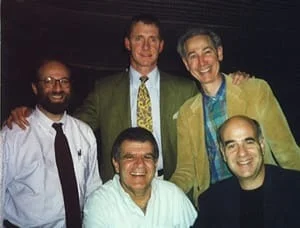Biggest Case
OUR BIGGEST CASE: A tireless search for justice with roots in World War II
How a Queens law firm recovers Hitler’s stolen money after 65 years
Get Personalized Legal Representation
Nacher v. Dresdner Bank
(In Re Nazi Era Cases) (Mandowsky/Nacher v. Dresdner Bank)
Wednesday, January 29, 2014 | 6:00 pm-9:00 pm
Panelists:
- Joseph N. Yamaner, Esq.
- Paul E. Kerson, Esq.
- Marc Crawford Leavitt, Esq.

CLE CREDIT: 3.0 CLE Credits in Professional Practice
Transitional Seminar- Valid for All Attorneys
This story is so fantastic, so unbelievable, so outside the realm of experience that we would not believe it ourselves had we not lived through 14 years of the Nacher v. Dresdner Bank and related litigation, from 1994 through 2008. NY Supreme Court, Queens County, Index #10193/94; 198 F.R.D. 429 (D.N.J. 2000); 213 F. Supp. 2d 439 (D.N.J. 2002); 236 F.R.D. 231 (D.N.J. 2006); 240 Fed. Appx. 980 (3d Cir. 2007); cert. den. 552 U.S. 1098 (2008).
It all started when Rabbi Meyer Perlmutter of the Reform Synagogue of Forest Hills, NY, asked a congregant, our law partner Marc Leavitt, to help a 93 year old man bearing a personal tragedy of life-time proportions. Ferdinand Nacher’s uncle Ignatz Nacher (credited with inventing pasteurization of beer) had been the majority owner of Engelhardt Breweries, Inc., one of Germany’s largest brewery, hotel and restaurant companies. In 1934, this industrial empire had been stolen at gunpoint by agents of the Dresdner Bank as agent for the Nazis. The proceeds of perhaps the largest theft of Jewish property in history were used to finance the Reign of Terror against the globe we have come to know as World War II.
Ferdinand was the Executor of his Uncle Ignatz’s Estate. He meticulously saved all the documents of unlawful seizure. When we met him, this frail but determined man was living on his Social Security payments and modest investments in his small rent-controlled Forest Hills apartment. His family had once been among the wealthiest in Europe. Ferdinand (and Ignatz) had been forcibly ejected from Germany in 1934, and he never got over this experience. For 60 years, he tried to get his family’s property back by writing letters to various American and German government authorities and pursuing unsuccessful lawsuits. A modest settlement for the West German properties had been received in 1956, but no recovery whatsoever for the East German properties had been paid as of 1994.
The Dresdner Bank maintained a branch in New York City. This is the story of how Paul Kerson crafted an ingenious strategy to pursue the Nacher claims in New York Supreme Court while avoiding defenses including statute of limitations and the anticipated objection of the U.S. government.
It is the story of how we obtained German co-counsel via the German consulate in New York – Sebastian Schuetz, a Hebrew-speaking Berlin lawyer who grew up in Israel, the son of the German Ambassador and later Mayor of Berlin. It is the story of parallel proceedings with post-reunification agencies of the German Government including meetings with officials who were sincerely sorrowful for what the Nazis did, and the trips he took with Joseph Yamaner throughout the former East Germany to inspect and catalogue countless Engelhardt properties.
It is the story of how, after Ferdinand’s death, Joseph Yamaner with assistance of Tali Sehati successfully located Nacher heirs worldwide and convinced them to produce critical documentation necessary to continue the domestic lawsuit as well as the proceedings in Germany that continue to provide the Nacher family with restitution.
Our law firm was the first to start litigation anything even remotely like this. This is the story of how we (years before the Swiss Bank revelations) inspired 56 other cases around the United States primarily involving so-called “slave labor” (often based on little or no hard evidence), of how the U.S. government took over all 57 and tried to settle all the Holocaust claims in the entire world with a $5 billion fund assembled from dozens of German corporations and the German government. And how Ronnie Mandowsky, Ferdinand’s grandnephew, understanding the “monkey wrench” he held that could bring the juggernaut to a halt, reluctantly agreed to withdraw the lawsuit and submit the family claims to the German Foundation for Remembrance, Responsibility and the Future.
Ironically, while the German government acknowledged and compensated those deprived of East German real estate by the Nazis, the joint corporate/government entity specifically created to achieve “legal peace” for the crimes of the century shockingly denied the Nacher claims entirely. And we fought all the way to the Supreme Court to try to restore them.
This is a story of hope, of faith, of courage, of teamwork, of law, of politics, of history, of government, of international finance, of ethics, of war and of imagination. It defies specialization of any type. It involves most of the subjects of a standard American law school curriculum – trusts and estates, criminal law, civil procedure, Constitutional Law, international law, torts, contracts, property, administrative law, evidence, corporations and commercial law.
While we have told the story of Nacher v. Dresdner Bank at several universities as guest lecturers, this is the first time we will be telling our Queens Bar Association colleagues exactly how we did what we did. There can be no doubt that this will be the most gripping and fascinating CLE that can be imagined. It is also a stark reminder that all the subjects of law are completely interrelated.

